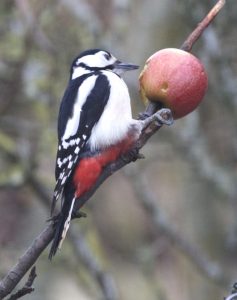 If you were to draw up a short list of peoples’ favourite attractive birds in the garden then one of the birds would surely be the great spotted woodpecker. Its sharp and strident call note that sounds like “kick kick” gives the birds away before it comes rushing in to utilise feeders such as those filled with peanuts or with suet balls. These delightful woodpeckers are about the size of a blackbird and they will come in very close to you to get at a feeder. It’s mainly black and white upperparts contrast with the white underparts. On it’s shoulders it has two large white patches with small white spots on its folded wings. The shoulder marks show as very conspicuous oval patches in flight. What makes the birds attractive are the broad areas of bright red feathers under the short stiff tail and the red feathers on the head of the males and juveniles.
If you were to draw up a short list of peoples’ favourite attractive birds in the garden then one of the birds would surely be the great spotted woodpecker. Its sharp and strident call note that sounds like “kick kick” gives the birds away before it comes rushing in to utilise feeders such as those filled with peanuts or with suet balls. These delightful woodpeckers are about the size of a blackbird and they will come in very close to you to get at a feeder. It’s mainly black and white upperparts contrast with the white underparts. On it’s shoulders it has two large white patches with small white spots on its folded wings. The shoulder marks show as very conspicuous oval patches in flight. What makes the birds attractive are the broad areas of bright red feathers under the short stiff tail and the red feathers on the head of the males and juveniles.
However, there is the dark side to this bird and you can get a hint of this at the local garden centres that sell bird nestboxes. Amongst the accessories of these are small metal plates with holes in the centres. These plates are for fitting over the entrance of the nestboxes to stop great spotted woodpeckers opening up the entrance hole. This is not, as some might believe, so that they can use the nestboxes themselves but so they can get at the young inside and eat them. If a great spotted woodpecker is determined even the metal plate will not stop them They also seem to have the uncanny knack of locating young in a nestbox by their incessant calling for food. Once located the great spotted woodpecker will use its powerful beak to drill its way through the side of the nestbox and get at the food – the chicks.
If the nestbox holes are big enough then the great spotted woodpecker will just reach inside and pull the chicks out and this has happened in our garden. The starlings, each year, occupy the doocot just outside the house. One year a female great spotted woodpecker , and only the female, found this food source and when the starling chicks were about three quarters grown systematically pulled the chicks out of each of the six holes and ate them. However, these birds do not always get it their own way and are predated themselves. One year in the garden I was watching the juvenile woodpeckers coming to peanut feeders to learn from their parents how to tackle the feeder. Suddenly there was an alarm call from an adult great spotted woodpecker and the juvenile bird I was watching that was sat on a fence at the time reacted to the alarm. The juvenile pointed its head up and just froze. This might have been well worked on a tree trunk but on the fence it was just so conspicuous and the sparrowhawk was on it and just carried it off. The calls of the adult woodpeckers made no difference as the young bird was fated.
Now is the time of the year when you can not only sex the great spotted woodpeckers but also age them as the juveniles will have left their nest hole. The adult females have no red feathers on their head at all. The males have the small patch of red feathers on the nape whilst the juveniles have red feathers all the way over the crown of their heads. Watch out for birds taking unusual food such as the adult female in the photograph taking apple.
Tags: highland birds
